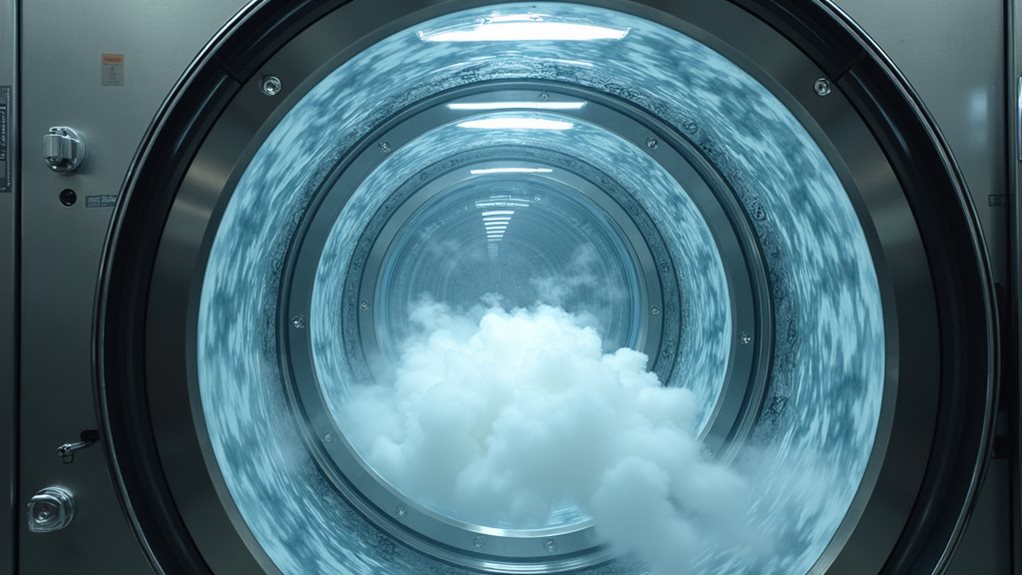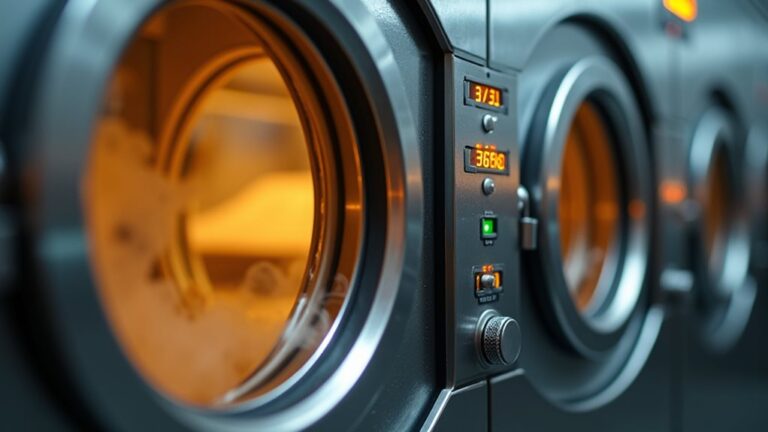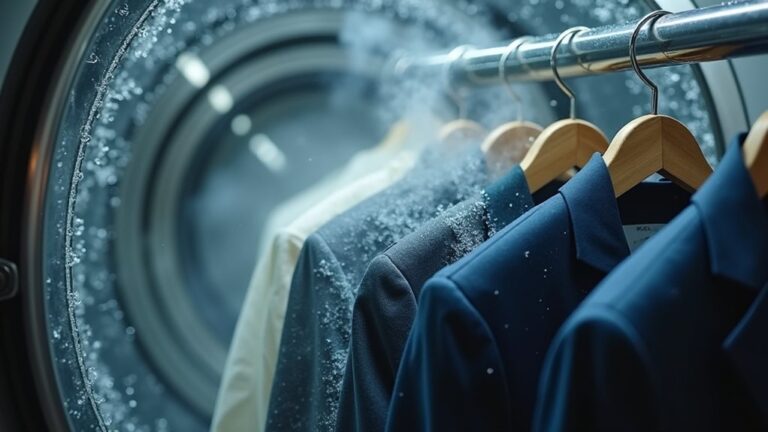When you drop off that silk blouse or wool suit, dry cleaners work their magic using chemical solvents like perchloroethylene instead of water, which would shrink or damage delicate fabrics. Your garments get inspected, pre-treated for stains, then gently agitated in a solvent bath that dissolves oils and dirt while preserving fabric integrity. After the cleaning cycle, technicians press and steam everything back to perfection, and here’s the fascinating part about what happens next.
The Science Behind Dry Cleaning
When I first discovered that “dry” cleaning actually uses liquid solvents, I felt like I’d been living a beautifully crafted lie my entire adult life 😅 — and honestly, the science behind this process is far more fascinating than the misleading name suggests.
The dry cleaning process relies on a solvent instead of water, typically perchloroethylene (perc), which dissolves oils and grease that water simply can’t touch. This cleaning performance makes it perfect for delicate fabrics like silk and wool, which would shrink or lose their shape with traditional cleaning methods.
Dry cleaning machines create mechanical agitation that tackles stubborn stains while maintaining fabric integrity, and the environmental impact stays minimal since 99.99% of solvents get recycled. The complete process includes pre-treating stains, immersing garments in the solvent bath, and finishing with drying and pressing to restore the clothing’s original appearance.
Chemical Solvents Used in the Process
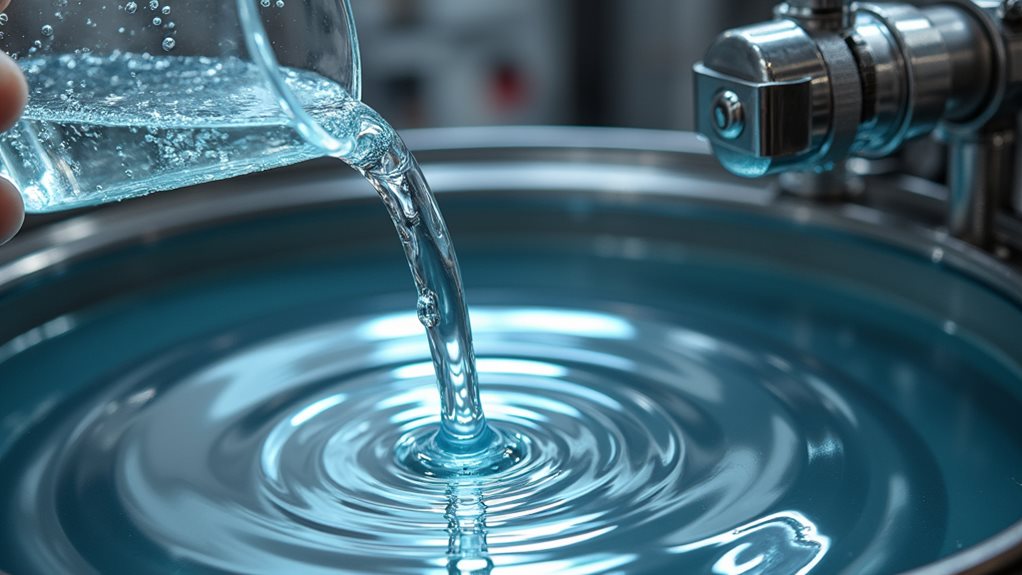
When you drop off your favorite silk blouse at the dry cleaner, you’re probably not thinking about the complex chemistry happening behind those swinging doors, but the solvents they choose can make or break your garment’s future.
Most cleaners still rely on perchloroethylene (or “perc” as we industry folks call it), which has been the go-to since your grandparents’ generation because it’s incredibly effective at dissolving oils and stains that water just can’t touch.
However, you’ll increasingly find eco-conscious cleaners switching to safer alternatives like liquid CO2 or plant-based solvents, especially since we’ve learned more about perc’s health risks – and honestly, it’s about time we prioritized both your clothes AND your wellbeing! 😊
The key properties that make any solvent effective for dry cleaning include chemical stability, non-flammability, and the ability to dissolve greases while remaining gentle on delicate fabric types.
Perchloroethylene Industry Standard
Since the 1930s, perchloroethylene—or “perc” as industry folks call it—has dominated the dry cleaning industry like that reliable friend who always gets the job done, even if they come with a few quirks you’d rather ignore.
This nonflammable powerhouse became the gold standard because it delivers effective cleaning without catching fire, plus it’s recyclable, which seemed pretty progressive back then.
However, those environmental and health concerns we’ve learned about over the decades are nothing to sneeze at—perc can cause color bleeding and has narcotic effects when you breathe it in.
That’s why regulatory frameworks like EPA regulations phased it out of residential facilities by 2020, pushing the industry toward alternative solvents for safer cleaning processes. 😅
Additionally, PERC residues can remain on clothing after the cleaning process, which is why it’s important to let garments air out properly before wearing them.
Eco-Friendly Solvent Alternatives
As the dry cleaning industry grapples with environmental responsibility, you’re witnessing a fascinating shift toward eco-friendly solvents that promise to clean your clothes without the guilt trip about harming the planet.
Gone are the days when perchloroethylene (perc) was your only option, despite its notorious health and environmental risks as a volatile organic compound.
Today’s sustainable dry cleaning offers you hydrocarbon solvent alternatives like DF-2000, which dramatically reduces exposure to harmful cleaning chemicals while maintaining that crisp, professional finish you expect.
Liquid carbon dioxide cleaning has become particularly exciting—it’s nearly non-toxic and incredibly effective!
While petroleum spirits and Stoddard solvent continue to serve many dry cleaning establishments due to their proven cleaning efficacy and established infrastructure, the industry increasingly prioritizes environmental considerations in solvent selection.
Modern facilities now utilize energy-efficient machines that recycle these eco-friendly alternatives up to 99.99%, proving that protecting both your wardrobe and Mother Earth can beautifully coexist.
Health and Safety
While these green innovations sound promising, you’ll want to understand the real health implications of what’s actually happening in most dry cleaning shops today, because despite all the eco-friendly buzz, the majority still rely heavily on perchloroethylene (PCE).
Though PCE delivers unmatched cleaning power, occupational exposure studies reveal potential neurological effects when workers inhale these fumes regularly.
Here’s what’s encouraging though – research shows dry cleaners don’t actually have higher cancer rates than other industries, which honestly surprised me when I first learned this.
The industry’s gradually embracing safer practices, implementing advanced solvent recovery systems and exploring biodegradable solvents as an alternative to perc.
Regulatory frameworks now assess the safety of chemicals more rigorously, pushing eco-friendly practices forward while balancing health and environmental concerns.
For consumers, brief exposure to dry cleaned garments poses minimal risk, though allowing clothes to air out before wearing helps ensure any residual chemical odors dissipate completely.
Step-by-Step Dry Cleaning Procedure
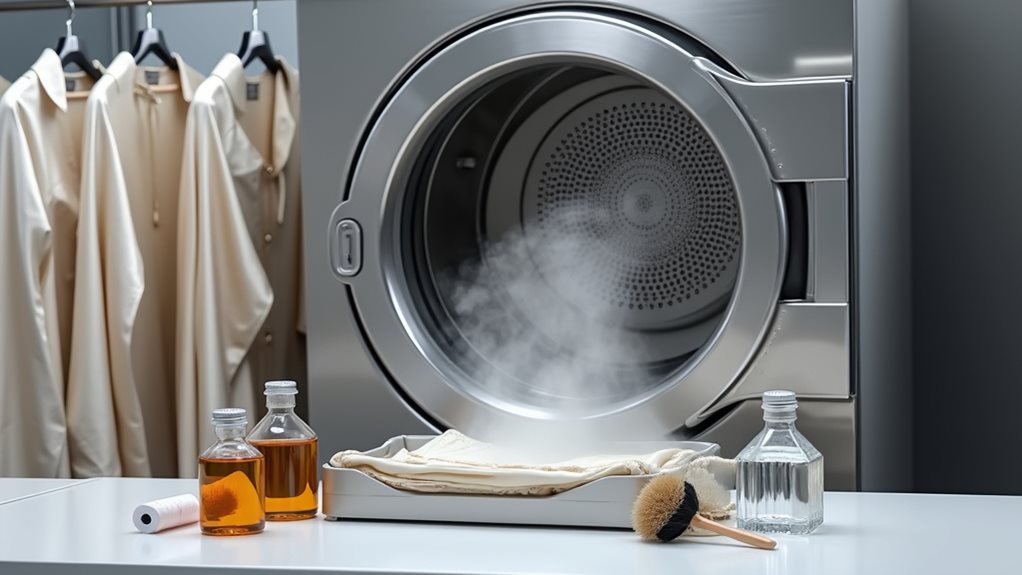
When you drop off your favorite blazer at the dry cleaner, you’re probably curious about what actually happens behind those mysterious curtains, and honestly, I was too until I watched the process firsthand during a tour last year.
The expedition begins with a thorough inspection where skilled technicians tag each garment for tracking, check pockets for forgotten treasures (you’d be surprised how many pens and gum wrappers they find!), and carefully examine fabrics for existing stains or damage that need special attention.
This pre-treatment phase sets the stage for the actual machine cleaning process, where your clothes will experience a gentle yet effective solvent bath that works magic on stubborn stains while preserving delicate fibers. The cleaning utilizes chemical solvents like perchloroethylene or eco-friendly hydrocarbon alternatives instead of water to dissolve oils and dirt without causing shrinkage or damage to delicate fabrics.
Pre-Treatment and Inspection
Before your favorite silk blouse or wool suit gets anywhere near the cleaning solvent, it undergoes what I like to think of as a thorough health checkup at the dry cleaner’s reception desk.
During this vital inspection phase, experienced technicians examine every inch of your garments, searching for stains, damage, or forgotten treasures lurking in pockets (trust me, they’ve found everything from gum to gold jewelry).
This careful assessment determines which cleaning method will work best for your specific fabric and any problem areas that need pre-treatment attention.
- Each garment receives an identification tag for tracking throughout the entire process
- Stains get targeted pre-treatment using specialized formulas designed for specific soil types
- Pocket checks prevent disasters and protect both your belongings and specialized dry cleaning machines
- The inspection guarantees gentle agitation settings match your fabric’s delicate needs, assuring efficient cleaning
The pre-treatment process focuses on stains that water-based washing cannot handle effectively, using targeted solutions before the garment moves to the main chemical solvent cleaning phase.
Machine Cleaning Process
Once your garments have passed their thorough inspection, they’re ready for the main event—the actual cleaning process that transforms your soiled clothes back into pristine condition through a carefully orchestrated dance of chemistry and mechanics.
Your pre-treated garments enter the dry cleaning machine, where they’re agitated gently in perchloroethylene, a remarkable solvent that dissolves oils and dirt without the harshness of water. This cleaning process typically runs 8-15 minutes, enough time to remove stains while protecting delicate fabrics.
Here’s where it gets impressive: during solvent extraction, approximately 99% recovered solvent gets recycled for future use, making the process surprisingly eco-conscious. After the cleaning cycle, garments undergo solvent extraction and drying, followed by pressing and steaming to restore their original shape and appearance. It’s like watching your clothes get a spa treatment!
Benefits for Delicate and Specialty Fabrics
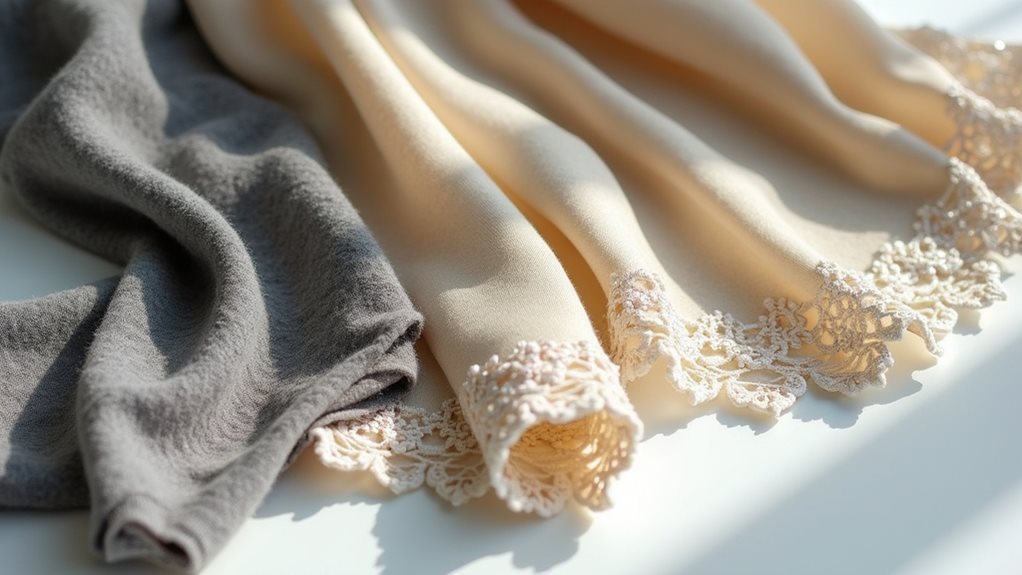
Although I learned this lesson the hard way after shrinking my favorite cashmere sweater into doll-sized proportions 😅, dry cleaning truly becomes your fabric’s best friend when you’re dealing with delicate materials like silk, wool, and cashmere.
Understanding how dry cleaning works protects these precious garments and helps you make smarter choices for your wardrobe investments.
Knowing the science behind professional cleaning transforms how you care for your most treasured clothing pieces.
Here’s why specialty fabrics thrive with professional cleaning methods:
- Gentle stain removal – Non-polar solvents effectively tackle oil-based stains without the harsh agitation that water washing requires.
- Color preservation – Your vibrant fabrics won’t fade like they’d under high-temperature water treatments.
- Shape retention – Delicate fabrics like velvet and suede maintain their original texture and appearance.
- Fabric integrity – The integrity of delicate textiles stays intact, preventing the distortion that traditional cleaning methods often cause.
The use of chemical solvents instead of water eliminates the risk of shrinkage, color bleeding, or structural damage that can occur with water-based washing methods.
Health and Environmental Considerations
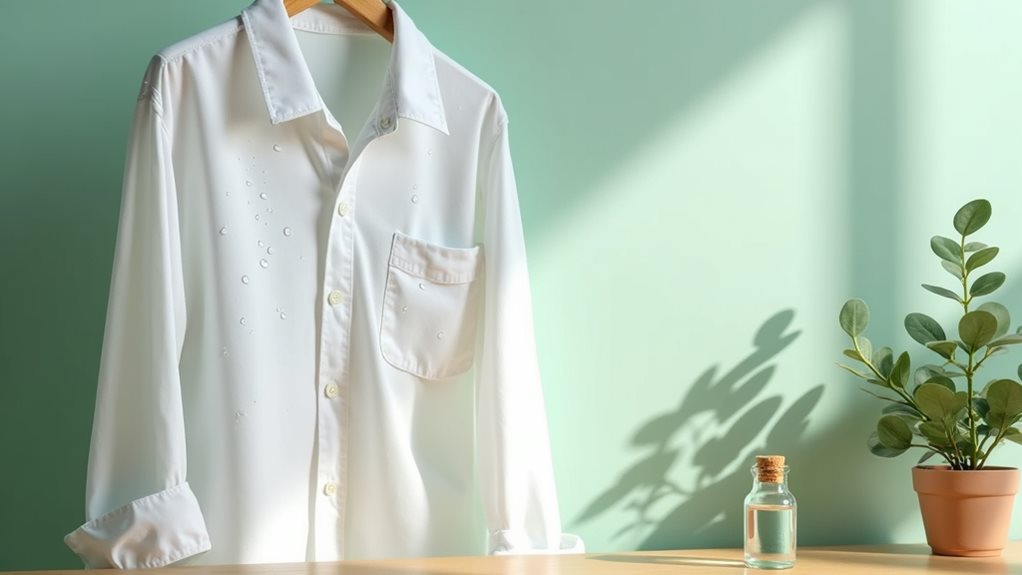
While dry cleaning works wonders for preserving your favorite garments, the chemicals involved deserve serious consideration for both your health and our planet’s wellbeing.
Traditional perchloroethylene (perc) creates health risks through occupational exposure, though the EPA banned it from residential facilities in 2020. You’ll find that toxic chemicals can leak into surrounding environments, making vapor recovery filters crucial in cleaning processes.
Here’s the encouraging news: the industry’s embracing change!
Alternative solvents like liquid carbon dioxide and high flash hydrocarbons are replacing harmful chemicals, while biodegradable cleaning methods reduce environmental impact considerably.
When choosing dry cleaners, ask about their solvents – many now use eco-friendly options that clean effectively without compromising your health or contributing to pollution. 🌱
To minimize exposure risks, always air out your dry-cleaned garments before wearing them, as residual chemicals can remain on clothing after the cleaning process.
Limitations and Fabric Compatibility
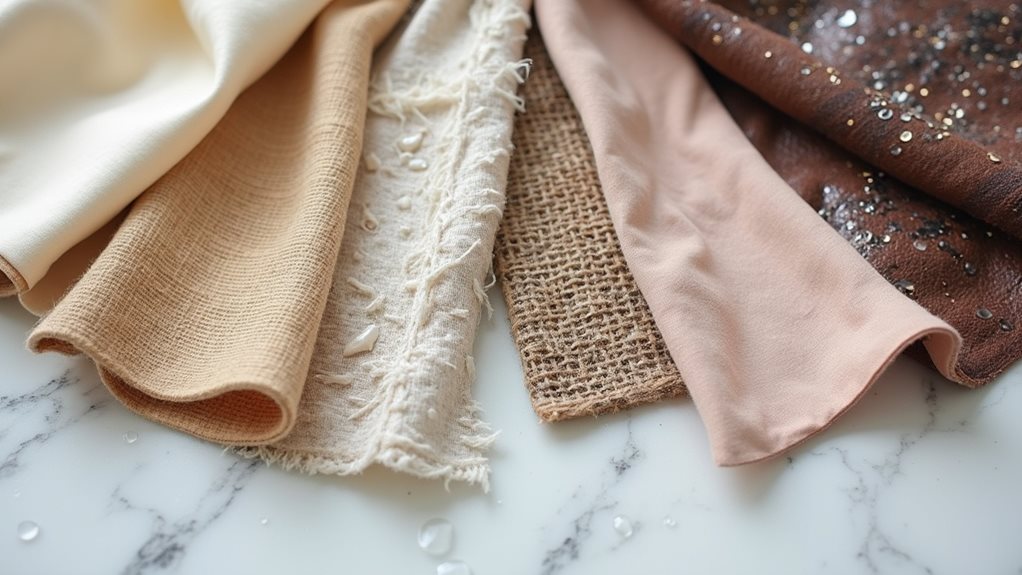
Despite dry cleaning’s impressive capabilities, understanding its limitations can save you from heartbreak when your favorite garment doesn’t emerge quite as expected.
While dry cleaning solvents excel at tackling oil-based stains, they often struggle with water-based stains like coffee spills or wine mishaps, which require different approaches entirely.
Here’s what you should know about fabric compatibility:
- Always check the care label before heading to professional cleaners—it’s your garment’s survival guide.
- Delicate fabrics like silk and cashmere thrive with the cleaning process, while sequins and plastic materials can suffer damage.
- Items marked “dry clean only” aren’t just suggestions; they’re desperate pleas from vulnerable fabrics.
- When in doubt, consult your cleaner about fabric compatibility—they’ve seen enough fashion disasters to guide you wisely.
Modern Eco-Friendly Alternatives

As environmental consciousness reshapes industries across the globe, the dry cleaning world has adopted a quiet revolution that’s transforming how we care for our most cherished garments.
You’ll find modern dry cleaning establishments embracing environmentally friendly solvents that’ll make your grandmother’s favorite silk blouse sparkle without poisoning the planet. Liquid carbon dioxide cleaning uses pressurized CO2 to lift stains gently, while high flashpoint hydrocarbons replace harsh synthetic petroleum chemicals that once dominated the industry.
These biodegradable solvents work alongside innovative wet cleaning methods, proving that caring for delicate fabrics doesn’t require environmental sacrifice.
Modern eco-friendly dry cleaning demonstrates that preserving delicate garments and protecting our environment can harmoniously coexist through innovative sustainable practices.
Today’s energy efficiency improvements mean cleaning solutions recover 99.99% of solvents, creating a sustainable cycle that protects both your wardrobe and the world around us.
Cost Factors and Care Guidelines

When you’re standing at the dry cleaner’s counter clutching your favorite cashmere sweater, you’ll quickly discover that quality fabric care comes with a price tag that reflects the specialized attention your garments deserve.
Understanding cost factors helps you make smart decisions about your wardrobe investment, especially when dealing with delicate fabrics that require professional cleaner expertise.
- Check care instructions religiously – those tiny labels save you from expensive mistakes and fabric disasters
- Budget $25-50 for multiple items – dry cleaners charge based on garment complexity and special treatments needed
- Consider stain treatments as insurance – paying extra upfront protects your high-end clothing from permanent damage
- View professional cleaning as preservation – regular maintenance extends your garments’ lifespan, making each visit worthwhile
Smart fabric care isn’t just about cost; it’s about protecting your style investments! 💫

